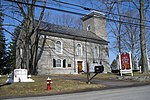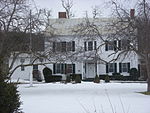In the early afternoon of October 6, 2018, a stretch limousine crashed at the junction of New York state routes 30 and 30A, north of Schoharie and 30 miles (48 kilometers) west of Albany. The crash killed 20: the driver, all 17 passengers, and two pedestrians who were in a nearby parking lot. The passengers were mostly from communities around the Capital District, primarily Amsterdam, and were on their way to celebrate a birthday at Brewery Ommegang near Cooperstown. Among them were four sisters and two recently married couples.
Investigators uncovered problems with the limousine, the driver, and the limousine company. The state had ordered the vehicle removed from service after it failed two inspections due to mechanical problems including deficient brakes; a shop hired to fix the brakes allegedly made inadequate repairs and then falsified their records. The vehicle was certified for only 10 seats but had 18 installed. The driver lacked the required endorsement to his license for carrying 15 or more passengers. The New York State Police (NYSP) determined that the operator, Nauman Hussain, was aware of these issues yet continued to rent the vehicle, and he was arrested and indicted on 20 counts each of criminally negligent homicide and second-degree manslaughter. In a September 2021 plea bargain, Hussain pleaded guilty to the charges of criminally negligent homicide on the expectation that he would not be sentenced to prison, but almost a year later withdrew that plea at his sentencing after the judge insisted on some prison time. He was found guilty of all charges in May 2023.
Larger issues have been implicated. The National Transportation Safety Board questioned whether safety regulations governing limousines, which critics have called lax, are sufficient to protect passengers; in September 2019, the agency issued an interim report suggesting that some passengers may have survived had they worn seat belts, and called on the industry and the state to do more to promote and mandate their use. The intersection of the two highways, which residents say remains hazardous due to its steep downhill approach, has been cited as a possible contributing factor despite efforts by the state to reduce the risk. The victims' families have filed civil lawsuits against the limousine operator, the state, a Pakistani tycoon, the repair shop and the store in whose parking lot the two pedestrians were killed.
The crash was, at the time, the deadliest transportation-related disaster in the United States since the 2009 Colgan Air Flight 3407 crash near Buffalo, which killed 50. It was surpassed the following year by the sinking of MV Conception off of Santa Cruz Island, California, which killed 34. It was also the deadliest road transportation disaster in the U.S. since a 2005 bus fire in Wilmer, Texas killed 23 nursing home residents evacuating from the path of Hurricane Rita.









